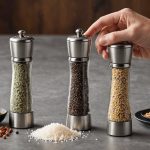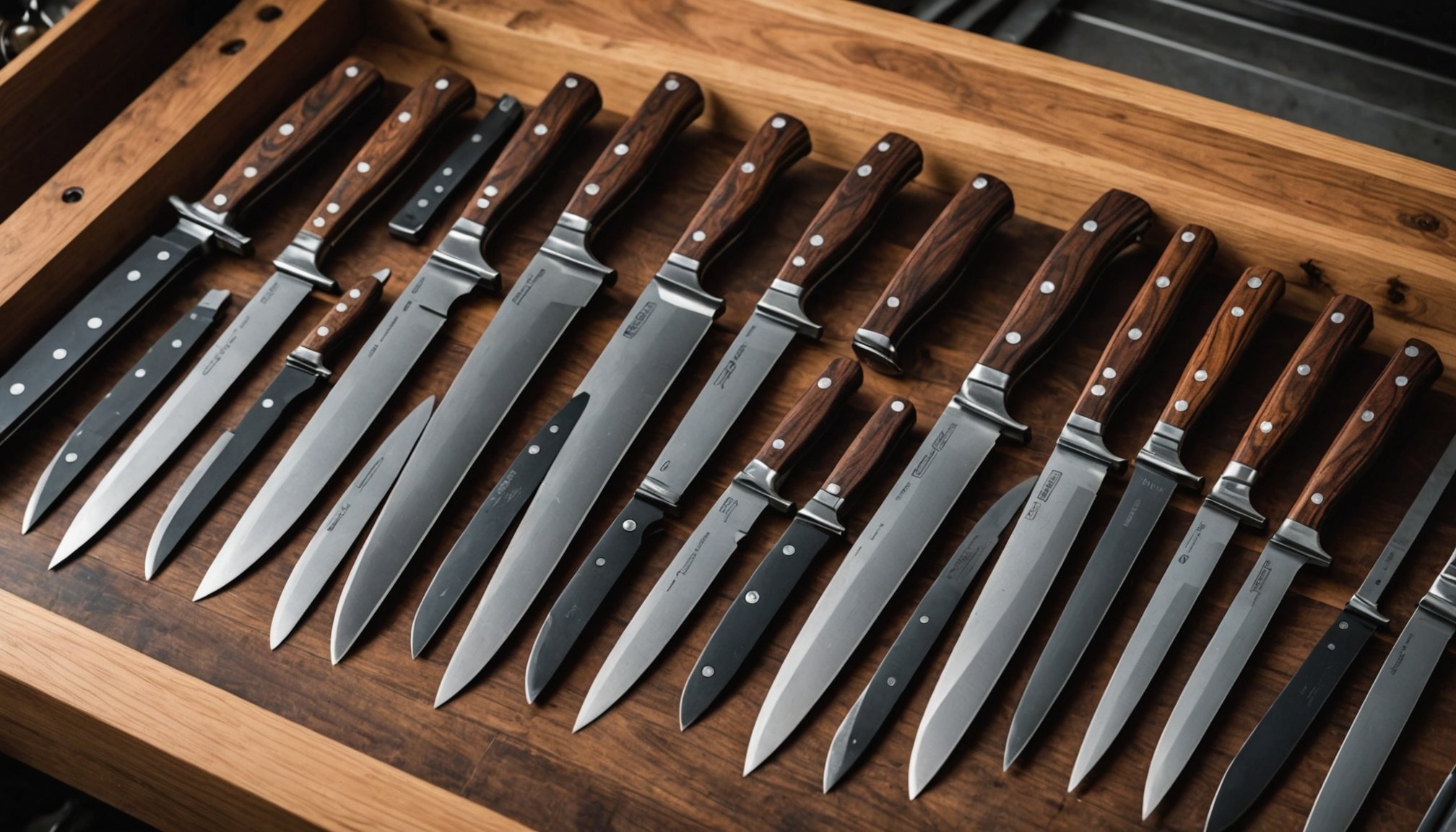Importance of Proper Knife Storage
Proper knife storage significantly impacts the sharpness and longevity of knives, extending their usability and performance. Incorrect storage methods can dull blades quickly, resulting in frequent sharpening and reduced lifespan. Effective storage practices ensure that your knives remain in optimal condition, ready for any culinary task.
The relationship between knife care and performance is often misunderstood. Proper storage is an integral part of knife maintenance that directly influences a knife’s performance. For example, storing knives in a protective sheath prevents chipping and retains the edge sharpness longer than when they are left loose in drawers, which can cause dullness and damage.
Additional reading : Discovering the Ideal Waffle Iron Size: Belgian vs. American Waffle Showdown
Common misconceptions about knife storage include the idea that any drawer will suffice or that storing knives in a block is foolproof. Not all knife blocks are created equal; overcrowding can cause nicks and dullness. Additionally, mishandling during block insertion can impact the blade. Knife strips, if incorrectly used, may weaken the knife’s magnetic hold and lead to falls. Understanding these storage pitfalls helps prevent unnecessary wear and tear on your cherished knives, ensuring their longevity and peak performance through time.
Best Knife Storage Methods
Proper knife storage utilises diverse methods to cater to different needs. Knife blocks are popular because they keep blades protected and readily accessible. However, to avoid nicks and dullness, ensure that knives fit comfortably in their respective slots without overcrowding. Knife blocks come in vertical or horizontal styles, and choosing the right type depends on available space and the number of knives in your collection.
Also to read : Top One-Handed Salt and Pepper Mills: Your Guide to Effortless Seasoning!
Magnetic knife strips offer a modern storage solution by displaying knives visibly and keeping them within reach. They help maintain blade sharpness as the edge doesn’t encounter abrasive surfaces. Consider installing magnetic strips at eye level for easy access while ensuring they are securely mounted to prevent accidents. Regular dusting prevents build-up on the magnets, ensuring a continued secure hold.
Knife sheaths provide maximal safety, especially for loose blades. They prevent unintentional cuts and preserve the blade edge. Available in materials like plastic and leather, selecting a sheath that fits snugly around the knife is essential for optimal protection. When storing knives in sheaths, periodically check for wear to ensure continued safety.
Each method offers distinctive benefits tailored to different environments and preferences, contributing to optimal knife maintenance.
Additional Storage Options
When considering drawer storage for knives, safety is paramount. Simply tossing knives into a drawer can dull blades and pose a risk. Drawer organizers are crucial in ensuring blade protection. They keep knives securely in place and prevent unnecessary movement, thus preserving their sharpness. For optimal use, select organizers with individual slots or adjustable compartments tailored to your knife collection.
For those on the go, knife rolls provide a portable storage solution perfect for chefs and culinary enthusiasts. These rolls protect blade edges while offering convenience and ease of transport. Durable materials like canvas or leather are recommended for longevity and protection. When choosing a roll, consider one with compartments that fit your knives snugly and securely.
Countertop options offer creative ways to display your knife collection. Besides aesthetic appeal, they ensure quick access to tools. Pros include visibility of your prized knives, but they also expose blades to environmental factors like moisture and dust. Regular cleaning is essential for maintaining both hygiene and condition.
Each storage option has unique benefits, so ponder your specific needs and kitchen environment. Proper storage not only enhances accessibility and safety but also contributes significantly to overall knife longevity and performance.
Maintenance Tips for Knife Longevity
Proper knife maintenance is essential for preserving the sharpness and function of your knives through time. Regular sharpening and honing keep blades performing at their best. Sharpening restores the edge, while honing smooths irregularities. For most kitchen knives, sharpening every six months and honing before each use is recommended.
To avoid rust and damage, thorough cleaning is crucial. Wash knives promptly after use with warm soapy water, avoiding abrasive sponges that can scratch the blade. Drying thoroughly prevents moisture-related rust or corrosion. Avoid dishwashers, as the harsh environment can dull blades and damage handles.
The frequency of maintenance depends on usage; a frequently used chef knife may need more attention than an occasional-use paring knife. Establish a routine based on how often your knives are used and inspect for signs of dullness or surface damage.
Integrating these practices into your culinary routine enhances knife longevity and performance. Remember, diligent care not only extends the lifespan of your tools but also ensures safety, enhancing your overall culinary experience. Proper care and maintenance transform good knives into an enduring part of your kitchen arsenal.
Common Knife Storage Mistakes
Improper knife care errors can drastically reduce the lifespan of your valued kitchen tools. One frequent blunder is storing knives in drawers without sufficient protection. This exposes blades to potential damage from clashing with other utensils, resulting in dullness and chipped edges. Investing in a designated drawer organizer can mitigate these risks, ensuring each knife remains safely in place.
Another common oversight involves overcrowding knife blocks or strips. When knives are crammed into blocks, it becomes difficult to remove them without scraping the blade against the sides, leading to unwanted nicks. Similarly, placing too many knives on a magnetic strip may weaken the magnetic hold, increasing the chance of a hazardous fall. Always distribute knives with adequate spacing to maintain safety and performance.
Ignoring environmental factors is another pitfall. Humidity can promote rusting, affecting blade integrity over time. If kitchen conditions are particularly humid, regular oiling of blades and using protective sheaths can help combat corrosion.
Mindfully addressing these storage pitfalls not only enhances the longevity of your knives but also upholds the quality and safety in your culinary workspace. Consistent evaluation and adaptation of storage practices are crucial to preserving your kitchen tools’ functionality.
Expert Recommendations for Specific Knives
Understanding the specific storage needs of different knives is essential for ensuring their longevity. Specialty knives require tailored storage solutions that respect their unique designs and functions. Proper care for each type of knife can significantly enhance its performance and lifespan.
Storing Chef Knives
Chef knives are indispensable in the kitchen and need meticulous care. To maintain them, consider individual knife sheaths or slots in a well-spaced knife block. These methods shield the blade from moisture and nicks, preserving its edge for precise cuts. Knife rolls are also advisable for travelling chefs, providing protection and convenience.
Storing Paring Knives
Paring knives, given their smaller size, require careful storage to prevent misplacement. Magnetic strips can be an ideal solution, offering visibility and accessibility. Another option is using drawer organizers with individual compartments, ensuring the knives remain secure and easy to extract.
Storing Specialty Knives
High-value or unique specialty knives should be stored with utmost care. Opt for custom-made storage options like bespoke blocks or knife sheaths designed specifically for the blade’s shape and size. For infrequently used specialty knives, storing them in a climate-controlled environment aids in preventing corrosion and maintaining their integrity.
FAQs about Knife Storage
Navigating knife care questions can be perplexing for many. One prevalent query is whether drawer storage is safe for knives. The answer is that while it is possible, using a dedicated drawer organiser is crucial. Such organisers prevent blades from clashing, safeguarding their sharpness.
Another frequent storage FAQ concerns the efficacy of magnetic knife strips. Magnetic strips are beneficial when correctly installed and maintained; they preserve blade sharpness and ensure easy accessibility. Safety is enhanced when strips are mounted at an appropriate height, away from children’s reach.
Misunderstandings about knife maintenance tips often lead to queries about the ideal frequency for sharpening. Kitchen knives typically require sharpening every six months, but frequent honing can sustain their performance in between sharpening sessions.
For those pondering the longevity of specialty knives, custom storage solutions like knife sheaths or bespoke blocks offer optimal protection tailored to each knife’s design.
Clearing up these myths and providing targeted advice helps in extending the longevity of knives. Consult resources that specialise in culinary tools for an informed approach to knife maintenance and storage. Regular reviews and expert advice ensure continued performance and safety of these essential kitchen instruments.











